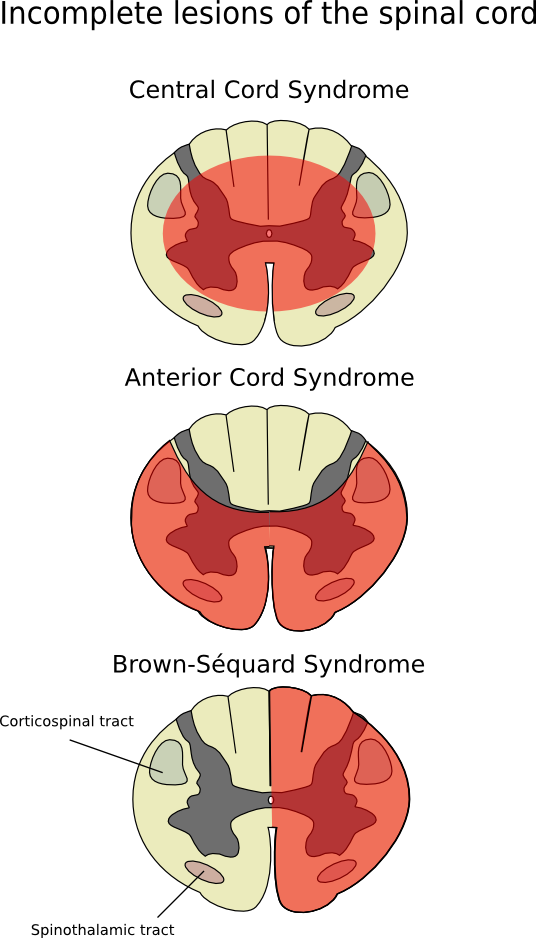
Anatomy
Central Nervous System
Transection of the anterolateral tract of the spinal cord results in which of the following clinical features:
Answer:
Transection of the anterolateral tract results in contralateral loss of pain and temperature sensations, starting one segment below the lesion.Spinal Cord Tracts
Anatomy / Central Nervous System
Last Updated: 28th March 2022
The spinal cord has numerous groups of nerve fibers going towards and coming from the brain. These ascending and descending tracts of the spinal cord are responsible for carrying motor and sensory stimuli to and from the periphery.
![By Polarlys and Mikael Häggström [CC BY-SA 3.0 (http://creativecommons.org/licenses/by-sa/3.0) or GFDL (http://www.gnu.org/copyleft/fdl.html)], via Wikimedia Commons](https://mrcemsuccess.com/wp-content/uploads/2017/01/Cross-sectional-cord.png)
Ascending and Descending Tracts of the Spinal Cord. (Image by Polarlys and Mikael Häggström [CC BY-SA 3.0 , via Wikimedia Commons)
Ascending Tracts
The ascending spinal cord tracts represent functional pathways that convey sensory information from the periphery to higher levels.
Table: Ascending Tracts of the Spinal Cord
| Tract | Location | Function |
|---|---|---|
| Dorsal Column Medial Lemniscus System | Posterior column | Transmits proprioception, vibration and fine-touch sensation |
| Anterior spinothalamic tract (decussates in spinal cord) | Anterior column | Transmits crude touch and pressure sensation |
| Lateral spinothalamic tract (decussates in spinal cord) | Lateral column (anterior aspect) | Transmits pain and temperature sensation |
| Posterior spinocerebellar tract | Lateral column (posterior aspect) | Transmits unconscious proprioceptive information to the cerebellum, involved in fine coordination of posture and movement of individual muscles of lower limb |
| Anterior spinocerebellar tract | Lateral column (anterior aspect) | Transmits unconscious proprioceptive information to the cerebellum, involved with coordination movement and posture of the entire lower limb |

Ascending Tracts of the Spinal Cord. (Image by OpenStax College [CC BY 3.0 , via Wikimedia Commons)
Descending Tracts
The descending tracts are functional pathways concerned with somatic and visceral motor activities.
Table: Descending Tracts of the Spinal Cord
| Tract | Location | Function |
|---|---|---|
| Lateral corticospinal tract | Lateral column (posterior aspect) | Involved in voluntary skilled motor activity of limbs |
| Anterior corticospinal tract (decussates in spinal cord) | Anterior column | Involved with control of axial muscles |

Descending Tracts of the Spinal Cord. (Image by OpenStax College [CC BY 3.0 , via Wikimedia Commons)
Clinical Implications
Table: Clinical Effects of Lesions of the Spinal Cord
| Spinal Cord Syndrome | Mechanism | Tracts Affected | Clinical Features |
|---|---|---|---|
| Complete cord transection | Major trauma | All tracts | Death (C1 – C3), paralysis of voluntary/automatic breathing (above C5), quadriplegia (C4 – C5), paraplegia (below T1), UMN paralysis below lesion, complete sensory loss below lesion, urinary and faecal incontinence, anhidrosis and loss of vasomotor tone |
| Brown-Sequard syndrome (hemisection) | Penetrating trauma | All tracts on one side | Ipsilateral UMN paralysis below lesion, ipsilateral loss of proprioception/vibration/fine touch sensation below lesion, contralateral loss of crude touch/pain/temperature sensation below lesion, bilateral lower limb ataxia |
| Central cord syndrome | Hyperextension injury of cervical spine in patient with pre-existing cervical stenosis | Lateral corticospinal tract, spinothalamic tract | Bilateral UMN motor and sensory loss with:
|
| Anterior cord syndrome | Occlusion of anterior spinal artery with infarction of territory supplied | Corticospinal, spinothalamic and spinocerebellar | Complete motor paralysis (flaccid at level of lesion and spastic below lesion), bilateral loss of pain and temperature sensation at and below lesion due to interruption of spinothalamic tract (but retained proprioception and vibratory sensation due to intact dorsal columns), autonomic dysfunction may manifest as hypotension (either orthostatic or frank hypotension), sexual dysfunction, and/or bowel and bladder dysfunction |

Incomplete Lesions of the Spinal Cord. (Image by Fpjacquot, via Wikimedia Commons)
Report A Problem
Is there something wrong with this question? Let us know and we’ll fix it as soon as possible.
Loading Form...
- Biochemistry
- Blood Gases
- Haematology
| Biochemistry | Normal Value |
|---|---|
| Sodium | 135 – 145 mmol/l |
| Potassium | 3.0 – 4.5 mmol/l |
| Urea | 2.5 – 7.5 mmol/l |
| Glucose | 3.5 – 5.0 mmol/l |
| Creatinine | 35 – 135 μmol/l |
| Alanine Aminotransferase (ALT) | 5 – 35 U/l |
| Gamma-glutamyl Transferase (GGT) | < 65 U/l |
| Alkaline Phosphatase (ALP) | 30 – 135 U/l |
| Aspartate Aminotransferase (AST) | < 40 U/l |
| Total Protein | 60 – 80 g/l |
| Albumin | 35 – 50 g/l |
| Globulin | 2.4 – 3.5 g/dl |
| Amylase | < 70 U/l |
| Total Bilirubin | 3 – 17 μmol/l |
| Calcium | 2.1 – 2.5 mmol/l |
| Chloride | 95 – 105 mmol/l |
| Phosphate | 0.8 – 1.4 mmol/l |
| Haematology | Normal Value |
|---|---|
| Haemoglobin | 11.5 – 16.6 g/dl |
| White Blood Cells | 4.0 – 11.0 x 109/l |
| Platelets | 150 – 450 x 109/l |
| MCV | 80 – 96 fl |
| MCHC | 32 – 36 g/dl |
| Neutrophils | 2.0 – 7.5 x 109/l |
| Lymphocytes | 1.5 – 4.0 x 109/l |
| Monocytes | 0.3 – 1.0 x 109/l |
| Eosinophils | 0.1 – 0.5 x 109/l |
| Basophils | < 0.2 x 109/l |
| Reticulocytes | < 2% |
| Haematocrit | 0.35 – 0.49 |
| Red Cell Distribution Width | 11 – 15% |
| Blood Gases | Normal Value |
|---|---|
| pH | 7.35 – 7.45 |
| pO2 | 11 – 14 kPa |
| pCO2 | 4.5 – 6.0 kPa |
| Base Excess | -2 – +2 mmol/l |
| Bicarbonate | 24 – 30 mmol/l |
| Lactate | < 2 mmol/l |

